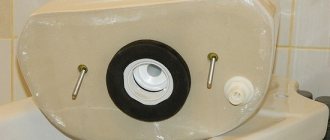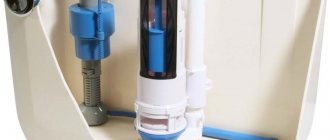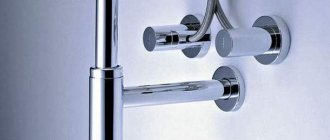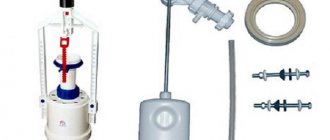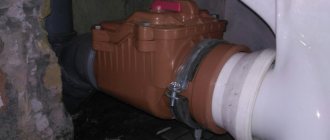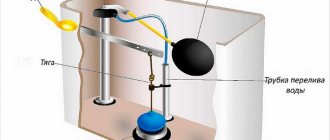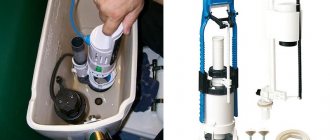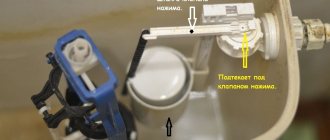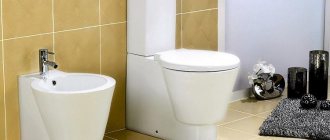Device diagram
This device appeared quite a long time ago; it was used several centuries ago, but then it did not become popular due to the lack of water supply and sewerage systems. The design of a modern toilet is much more complex than that of its predecessor.
The device consists of a bowl, a tank, shut-off valves and a drain assembly designed to release water (read: “Shut-off valves for the toilet - selection and rules for replacing the valves of the tank for draining water in the toilet”). The diagram shows how the toilet is structured in section - in the upper part of its bowl there is a seat with a lid. The device has a simple design, but there are certain nuances regarding the operation of the drain.
From the history of the toilet
The first toilet equipped with a flush cistern was designed for the Queen of England. This was in 1596. However, during this period there was not even a sewerage system in the design, which seriously hampered the spread of this equipment. Development has stopped.
The inventors were able to return to further research and design only after 150 years - a device appeared that resembled modern compact toilets. This was the development of the English engineer T. Twyford. He named the model Unitas, which means “Unity”.
Principle of operation
The working process is carried out in the drain tank. It consists of a device for filling the tank and a mechanism for flushing water into the toilet. It enters the container through a special hose from the water supply network. To ensure that the liquid is in the tank in the required volume, a filling device is used. When the amount of water in the tank reaches a predetermined level, the shut-off valve stops flowing.
After a person presses the button, the flush mechanism of the toilet tank is activated. The liquid from the container enters the bowl in portions; it has a high movement speed, so it can quickly and efficiently send sewage into the sewer network.
Few consumers are familiar with the structure of the toilet cistern, but the performance of the entire structure depends on its correct settings.
Liquid can be supplied to the device in different ways:
- above;
- below.
Feeding from above is carried out as follows. There is a shut-off valve at the top of the tank, but water enters it from a side channel. There is a float on the inner section of the lever. When the liquid in the reservoir reaches the required level, this element rises.
The rod is now pressed by another lever, as a result of which the valve is pressed and the hole is closed. This toilet structure is the most common. It is mounted on many plumbing fixtures.
If the design provides for a bottom supply of liquid to the device, then the drain fittings are located at the bottom of the tank. When using the equipment, the float moves vertically relative to the direction of the rod.
As a result of its movement, a shut-off membrane is activated, which is used to regulate the level of liquid inside the container. The advantage of bottom feed products is their quiet operation.
Types of toilets according to bowl geometry
The shape of the bowl should be such as to provide maximum comfort during use, a high level of hygiene and functionality. There are several forms of the product:
- Funnel-shaped bowl. The main advantage of this geometry is hygiene. This is achieved by the special position of the funnel - it is located in the very center of the bowl. The funnel allows you to very quickly and thoroughly remove waste products. The disadvantages include a splash, which with such a structure will definitely occur - design features.
- Plate-shaped bowl. This design features a flat platform where waste accumulates. The platform can be cleaned only with water jets. This is an outdated solution, although the shape prevents splashing. Devices with similar geometry are less common on sale, since its hygiene is extremely low.
- Visor bowl. Widely used bowl geometry. There is a ledge that prevents splashes. A special shape with a slope allows you to wash off feces from the walls without leaving a trace.
Tank filling process
In the case where the supply hose is located on the side in the toilet tank diagram, the water level is adjusted by changing the parameter of the spoke, which has a float at the end. Sometimes toilet models use thick brass wire instead of a knitting needle. The higher the float, the greater the volume of liquid will enter the tank.
Plumbing manufacturers are increasingly replacing metal elements with plastic products. But it is impossible to bend them, as they will break. In this case, the toilet flush cistern design provides for the float to move up or down along the pin, as a result of which the volume of liquid changes up or down.
In some designs, to simplify level adjustment, there is a threaded rod used to change the location of the displacer. If the liquid is supplied from below, the float rod is located vertically. The water level can then be adjusted independently. To do this, the float is moved to the lower mark and its position is fixed on both sides with special nuts.
When carrying out this work, you need to remove the lid with the attached button from the tank. In some devices it is rigidly connected to the flush valve. To prevent damage, the design of the toilet cistern with a button must be disassembled as carefully as possible.
First, unscrew the clamp on the button and only then remove the cover. When the float is on top, but does not block the water flow, the malfunction has arisen as a result of incorrect operation of the inlet valve. This part is disassembled, cleaned and put back together or a new one is purchased.
Drain mechanism
When it is necessary to wash away sewage, the user presses the button, and then everything happens without his participation. When pressed, the flush mechanism for the toilet tank is activated, the drain valve opens and water leaves the container. Streams of liquid enter the bowl and, after washing away the sewage, are sent to the sewer.
In any plumbing fixture, the filling device and the flush mechanism for the toilet tank are interconnected, although these units are completely different. This means that when you press the button, water begins to flow out and at the same time the tank is refilled, without the need to perform special actions.
There are models in which the toilet flush mechanism is activated using a rope (chain) or lever that must be pulled. Water drainage systems differ in assembly. If they break, you need to purchase a new product and install it.
A simple and long-used design of a drain siphon is a pear, shaped like a plunger. The mass of water presses it against the hole and thereby blocks the drain.
When a person presses the toilet flush lever, the bulb rises to the top and thereby releases water from the hole. The flow of liquid immediately turns on, the pear weighs more and, due to gravity, returns to the saddle.
The toilet flush cistern has an overflow tube that is constantly open, and its upper end rises above the water at a certain distance. If the tank overfills, excess liquid begins to flow into the sewer network.
Features of the dual-mode drain design
In modern models, the buttons on the toilet have two keys; by pressing one of them, you can use water sparingly.
A similar toilet flush device operates in two modes:
- Standard
. In this case, all liquid from the tank in the amount of 4 - 6 liters is discharged. - Half
. After pressing the drain button, only half the volume of the tank is released.
This design of the device is more economical in terms of water consumption, but it is more difficult to configure and repair. In this case, the number of parts that make up the toilet is greater, which means it will break more often.
In addition to products with two buttons, single-button devices are also sold, in which the amount of liquid ejected is controlled by the force of pressing the button. With a weak impact, half the volume is released, and with a strong impact, the entire tank is released.
Accessories for toilets
Modern designs are turning into robotic equipment - for example, in public toilets in Japan, the equipment thanks you for going into it. The electronics itself starts the drain.
We also produce many accessories for people with disabilities. They cannot always use the toilet properly. For such cases, toilet seat covers are made for disabled people. They are designed to equip the structure with handrails and increase the height of the device. The attachments are versatile and have the necessary adjustments. There are models on sale for people with any disabilities and other diseases.
Toilet covers for disabled people make their life even more comfortable and using the plumbing fixture becomes more enjoyable.
Adjusting the amount of water drained
The operating principle of the toilet allows you to independently adjust the flow of liquid into the tank. New fittings are always adjusted so that the water in the tank is at its maximum level.
To change the liquid level in a one-button tank, perform the following steps:
- Using a tap located before the supply hose, shut off the flow of liquid into the tank. If this valve is missing, the cold water in the entire apartment is turned off.
- Press the button to drain the contents of the device.
- Unscrew the drain plug, take the rim by the bolt, and remove it. To avoid breaking the fittings, the lid should not be lifted until the plug is removed.
- Next, lift the lid to look at the water level. He is usually the tallest. There are divisions on the overflow tube - with their help you can find out the level of water discharge.
- They are looking for a float - it is usually connected to a foot for supplying liquid.
- To reduce its flow, tighten the screw on the valve mechanism clockwise.
After completing the adjustment, check the level of fluid rise. Its surface should be located at a distance of 3 centimeters from the overflow tube. When the toilet is working properly, place the lid in place and tighten the button.
